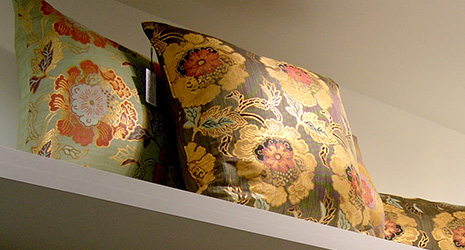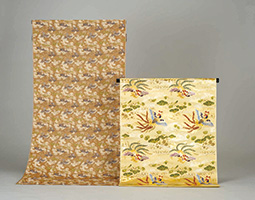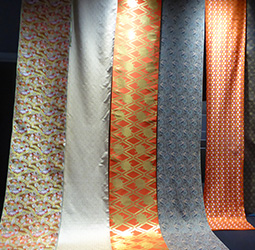October 2022
- English
- 日本語
Nishijin Kinran: Kyoto’s Magnificent Gold Brocade

Nishijin Kinran cushion covers 
Close-up of Nishijin Kinran place mats

Nishijin Kinran obi (kimono belt) fabrics 
A display of Nishijin Kinran obi (kimono belt) fabrics

Kinran, a type of gold brocade, is a luxurious fabric distinguished by its use of gold thread. “Nishijin Kinran,” gold brocade made in the Nishijin district of Kyoto, is especially famous among such fabrics for its high quality and rich expressiveness. This magnificent gold brocade combines the traditions of Kyoto Nishijin weaving with modern technology.

Silk weaving conducted in the northwest of urban Kyoto is called “Nishijin weaving” and boasts a history of more than 1,000 years. Fabrics produced in Nishijin using thread wrapped with gold leaf, so-called Nishijin Kinran fabrics, have an especially luxurious appearance and have been admired since ancient times. Their exquisite beauty comes from weaving gold-covered threads into the weft to create patterns.
Yamazaki Seiichiro, vice president of the Nishijin Textile Industry Association, explains, “In Kyoto, kinran has long been used for Buddhist monks’ robes and ritual implements. The patterns used differ depending on the sect. In addition to its religious uses, kinran is used to make bags for tea utensils, decorative cloth for hanging scrolls, and the costumes worn by Japanese dolls. These are the four main uses of kinran, with specialist weavers for each.”
Kinran was first imported to Japan from China in around the 13th century, and production in Nishijin began in earnest when the techniques for making the cloth also arrived in the late 16th century. The manufacturing technique of the gold thread itself and the technique of weaving “leaf yarn” (hakuito), in which gold leaf is stretched thinly and pasted with lacquer on handmade washi paper and cut into thin threads, were improved by many craftsmen throughout the Edo period (early 17th to mid- to late 19th century). Through the hand-weaving process, leaf yarn blends well with the silk thread, creating a splendor and texture unique to kinran. Eventually, during the Meiji period (1868–1912), as Japan modernized, kinran production increased sharply due to the spread of Jacquard looms.* Since the finish of textiles from Jacquard looms differs depending on the combination of warp and weft threads, gold threads that are easy for machines to handle were developed, with gold leaf strips wrapped directly around the thread. However, the traditional technique of using leaf yarn has been steadfastly preserved in the production of Nishijin Kinran.

There are various types of gold leaf depending on the purity of the gold used (gold content), but gold thread using expensive pure gold leaf has been strictly distinguished as “hon-kinshi” since ancient times and has been the material used for producing Nishijin Kinran.
The patterns expressed in Nishijin kinran are said to have developed based on the textiles used for the bags to contain tea utensils loved by samurai lords and famous tea masters from the second half of the 16th century onward as well as the kinran held in the Shosoin Repository via the Silk Road, but nowadays they are created freely using computer programs, ranging from complex patterns to reproductions of photographs. The motifs have also developed in a variety of ways according to the times, from traditional ones centering on auspicious natural objects, such as birds and clouds, to geometric and modern patterns.
Nishimura Tetsuya, executive director of the Nishijin Textile Industry Association, says, “There are twelve types of weaving techniques in Nishijin designated as national traditional crafts, such as tsuzure-ori** and kasuri-ori.*** By combining these techniques with kinran that uses gold thread, we have acquired a rich expressiveness that is exquisite. Kinran is currently produced in several places in Japan, but in 2007 we registered it as a regional collective trademark under the name ‘Nishijin Kinran’ to guarantee the quality of Nishijin weaving.”

Long-practiced traditions and modern technologies coexist in Nishijin Kinran, fabrics whose magnificent beauty remains undimmed.
* Automatic loom invented in France in 1801.
** In tsuzure-ori, weavers weave precise designs using their fingertips, as if spelling out letters.
*** Kasuri-ori means weaving with threads dyed according to a pattern in advance before folding.

